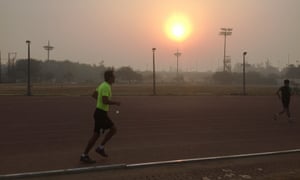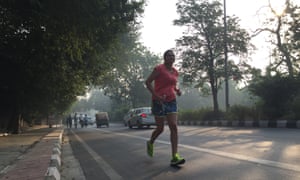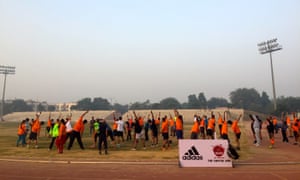
Despite it being 5:30am, Avdesh Nagar seems remarkably perky. But then this 15-year-old son of a dairy farmer is used to early starts. Running inDelhi is a dawn sport, and running is Avdesh’s life.
He looks the part, sort of. Short for his age, his physique is that of a natural runner: languid of limb, light of foot. He is decked out in the right kit, too, only every item – his trainers, his leggings, his T-shirt with its “So fast” logo – is tired and threadbare. Nagar has his coaches’ confidence, however, and for this ambitious teen that’s enough. “Only my mum and my coaches are supporting me,” he says. “My father, my brothers, they say running is a waste of time. Better to study, to work.”
In this city of almost 18 million people, a small but growing group of early risers shares Nagar’s passion for running. Drive the predawn streets of downtown Delhi and their shadowy figures can be made out plodding along the roadside in the early morning smog.
Delhi’s emerging running scene (the first organised road race in the capital was only in 2005) coincides with India’s gradual growth in prosperity. As the country’s wealth rises, so too do its rates of obesity, diabetes and other so-called “lifestyle diseases”. Exercise more, India’s doctors are counselling.
However, few of those pounding the capital’s pavements or jogging along the leafy footpaths of Nehru park or Lodi gardens herald from Nagar’s side of town. Born and raised in Gharoli, a run-down neighbourhood in east Delhi, Nagar struggles to cover the bus fare to his downtown training sessions. As for buying new kit, forget it.
“These guys here are just as talented as the Kenyans or young runners anywhere in the world,” says Vijay Shukla, stand-in coach for Nagar and his training group of 20 or so other low-income teenage athletes. “But the coaching isn’t there yet, and the government does very little to help.”

Running in Delhi is hard enough at the best of times. If the crazy traffic, air pollution and extreme heat don’t put you off, then the lack of green spaces, the stray dogs and – for women – the incessant “eve-teasing” probably will.
For those on low incomes, the challenges are even greater. First, there’s the price of the kit. Running shoes in any one of the Nike, Adidas, Puma or Reebok stores that line Connaught Circus in central Delhi range from R3,000 (£30) to R16,000 (£157). Nagar’s parents together earn around £3 per day.
Then there’s finding where to run. Delhi’s athletics facilities benefited from considerable investment in the runup to the Commonwealth Games in 2010, but access for members of the public is limited.
This leads to the kind of dilemma facing Komal Preet Kaur, a 25-year-old charity worker from the south Delhi district of Malviya Nagar. There are no parks near her home and, as a single woman, she feels uncomfortable running on the streets.
Her other alternative is to go to the government-run Siri Fort Auditorium, which has a track but is located 2.5 miles (4km) from her house and costs around R60 (60p) to get in.
“It’s more than I want to spend on going for a run. Plus, as well as being expensive, membership is usually only given to high-end people,” she says.
Nagar has encountered similar challenges. The group of up-and-coming teenage runners whom he trains with used to practice at the nearby Vinod Nagar Phase 2 Complex. Now, as a consequence of what his senior coach, Ian Ladbrooke, diplomatically calls “political problems”, they have to practice on a football pitch nearby.
“Basically, when our runners started beating all the neighbourhood groups, the other local coaches complained about the ‘foreign coach’ being in their stadium,” says Ladbrooke, a UK national and head of the Nike + Run Club in Delhi.

Ladbrooke first went to India to advise on a film about the 50s Sikh running legend Milkha Singh, entitled Bhaag Milkha Bhaag (Run Milkha Run). He now coordinates his own running-based fitness group in the capital for about 60 adult runners, most of whom are well-off professionals.
Donations from members of his private get-fit clients provide Nagar and a handful of other high-potential youngsters with a stipend of R5,000 per month. The rising star from Gharoli also receives periodic gifts of running trainers and kit from firms in the UK.
“Before it was always difficult for me to buy the food I needed for my training,” says Nagar. “Thanks to Coach, now it’s less of a problem. I eat well.”
Although the big running brands are investing heavily in promoting running inIndia, their target is not Delhi’s poor, and consequently little of their sponsorship money finds its way to the grassroots.
The onus, therefore, falls on private race organisers and running coaches to help those less fortunate. One of those is Ravinder Singh, a fitness professional who began a neighbourhood running group in Gurgaon, a glass-towered business district on the edge of Delhi.
Singh organises charity runs and demonstration races in under-privileged schools, helping raise awareness about the health benefits of running. With sponsorship from participants in his Couch to 5km programme, his charity – theRun with Me Foundation – has provided free running kit to around 30 low-income runners.
Recent years have seen a jump in funruns and organised races around the Indian capital, which also help to spread the word about the sport. The latest Delhi half-marathon event, for example, attracted nearly 34,000 participants across all categories. In 2005, the figure was in the low hundreds.
In another move designed to promote healthier lifestyles, the city authorities briefly close Connaught Place in central Delhi to traffic on Sunday mornings. Yoga sessions, aerobics classes and other exercise activities are then laid on for the public.
“In India, people see a crowd and they come along out of curiosity,” says Tanvir Kazmi, who recently organised a series of races around Delhi’s Formula 1 track. “I’ve seen people running in trousers and chappals [sandals] before, even salwar-kameez.”

As well as the health benefits of running, another incentive for low-income individuals to take up the sport is the possibility of landing one of the government jobs reserved for high-performing sportspeople.
To really reach the masses, however, running needs more high-profile role models, according to Shukla. It helps that Anil Ambani, one of India’s richest men, is a keen marathon runner. Yet because of the body images projected by Bollywood, young people are “too impressed with muscles”, preferring to hit the gym rather than go out running.
“If you have someone from your locality who runs, then it gives you a boost,” Shukla says. “You think to yourself: ‘I can do it too.’”
If true, then expect to see an uptake in running among the residents of Gharoli in coming months. Because, in Nagar, the east Delhi district can now count its very own under-16s 2,000m Indian record holder.
“My dream is to one day compete in the Olympics,” says the 15-year-old, fresh from his victory at the National Junior Athletics Championships. “Not just compete, actually. I want to win.”
Oliver Balch is author of India Rising: Tales from a Changing Nation, a grassroots account of the world’s largest democracy in the 21st century
[Source:- The Gurdian]
